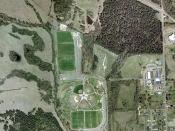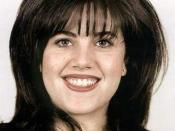The Clinton Impeachment happened only six years ago, but the story that erupted in the White House has been called the most publicized scandal in American history. Although most Americans know the role of Monica Lewinsky in the scandal, there were other key characters, behind the scenes, who played a role in the story. The American media had a large impact on the Clinton Impeachment.
On November 29, 1993, Kathleen Willey asked President Clinton for a job and he supposedly touched Willey in a sexual way. Linda Tripp saw Willey leaving the President's office. "I can tell you that she was very excited, very flustered. She smiled from ear to ear the entire time ... She seemed almost shocked, but happy shocked" (Kalb 34). According to Tripp, Willey did not look as if she had been offended by the President's advances. "Linda Tripp is a character for the ages ...
nosy, shrewd, principled, conniving, cynical and moralistic" ("Clinton and the Intern" 30). In early July of 1997, after sitting on the story for almost four years, Linda Tripp learned that Newsweek had caught wind of the Kathleen Willey incident. Tripp had first-hand knowledge of a juicy story about to break. On August 11, 1997, Newsweek published its account of the Clinton-Willey encounter, sourced to Linda Tripp.
From the beginning, Paula Jones' lawyers had been using the press to gain support for their case. Jones' lawyers "wanted bombshell coverage - Jones 'live' on CNN, excerpts on the evening news, front-page stories in the Post and the Times, radio reports on the hour" (Kalb 28). In early October of 1997, Paula Jones' lawyers heard rumors about Monica Lewinsky and subpoenaed Linda Tripp. A reporter for Newsweek, Michael Isikoff, "knew that Tripp, a source he had been cultivating since the winter of 1997,



Good
Very in depth.
2 out of 2 people found this comment useful.